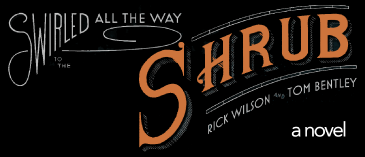About the Book
The Roaring Twenties were bellowing along—until they weren’t. In a splintered bar in Boston, Pinky deVroom, newspaperman, amateur cynic and would-be-novelist, clutches his sour Prohibition brandy and watches his world get sucked down into the vortex. Hope comes in the form of an astute, comely literary agent named Elfred. But hope can be its own form of hell. Watch game Pinky twist, squirm and waffle while the world wobbles.
Literature has never had a hero named Pinky—but despite literature’s measured qualms, this is its greatest chance.
Swirled All the Way to the Shrub is a 92,000-word novel, a collaboration between Richard Wilson and Tom Bentley. The book starts at that precise moment when the Roaring Twenties was crushed down into the Whimpering Twenties by The Crash, the biggest single economic tragedy in American history. After years of obscure effort (and the dull routine of his society-column pandering), Pinky is just on the cusp of literary success, but with the publication of his novel put on hold by the Crash, he is crushed right along with the Market.
Pinky instinctually knows the right thing to do, but his demons continually stand in his way. His antagonist is his own bruised and halting sense of self, which wrestles with the better angels of his nature.
His literary agent (and love interest), Elfred Norcross, is brilliant, competent, in control and on time. She has a difficult time when the world around her—and the people in it—don’t measure up to her standards. But her unbending expectations are tempered by a generosity of spirit, an acute discernment of people and their motivations, and her understanding of her own strengths and limits.
The Depression and Prohibition’s consequences are fundamental to the work, as are the appearances of some real-life figures such as Sylvia Beach of Shakespeare & Company and Alice Hamilton, the pioneering scientist. The effects of lead poisoning, the unfettered joys of the “banana messenger” and the glories of Telechron clocks also have their time in the sun. As do rigorous bartending practices and the perils of owning a hat.
But all those tributaries of the story return to Pinky: Through continued tests and failures, through the comradeship of real friends, through his own lacerations and partial healings, will he find fulfillment? Will good friends, a mysterious secret society, and the judicious prodding of the remarkable Doctor Alice Hamilton help him get the girl, the book deal, or at least hang on to his job? Or his hat?
Novel Themes and Concepts
We wanted to write a novel that starts at that precise moment when the Roaring Twenties was crushed down into the Whimpering Twenties by The Crash, the biggest single economic tragedy in American history. And this ignoble setting allowed us to take a flawed but generally likable fellow who was just on the cusp of fantastic success after years of noble effort and crush him down right along with the Market.
Tom’s Themes/Concepts
Our protagonist, Pinky is a good man with substantial weaknesses. He instinctually knows the right thing to do, but his demons continually stand in his way. His antagonist, his enemy (which must be overcome or all is lost) is his own bruised and halting sense of self, which forever gets in the way of the better angels of his nature. We continually test Pinky through his challenges, through the comradeship—not always comradely—of real friends, and through his own lacerations and partial healings,
In some
Rick’s Themes/Concepts (and Secondary Character Briefs)
Pinky DeVroom has written a superb
Natchez is, on the surface, a happy-go-lucky dilettante, sailing through life with the least constraints on his actions (and feelings) that he can manage, after being disowned by most of his family for the results of his self-involved behavior. Deep inside, he is scared and alone and may want something more out of life.
Elfred Norcross is brilliant, competent, in control and on time. She has a difficult time when the world around her—and the people in it—don’t measure up to her standards. So difficult that she suffers even more than those close to her, who feel the effects of her unbending expectations.
Morris Fierman is merely an elevator operator, one of
